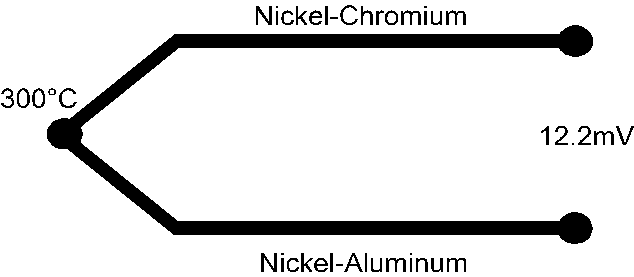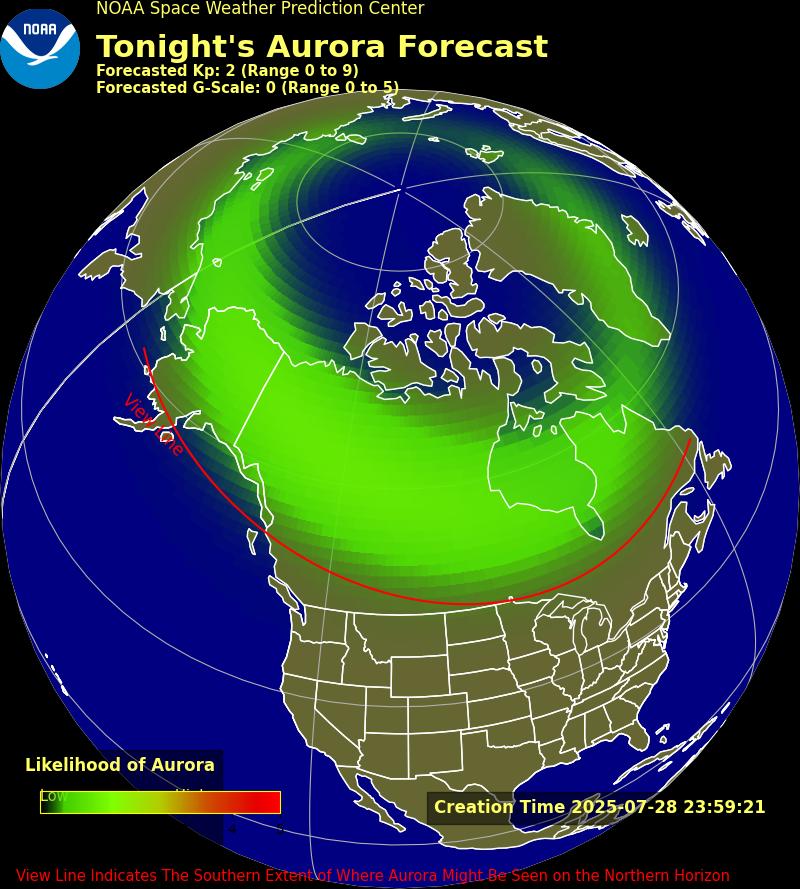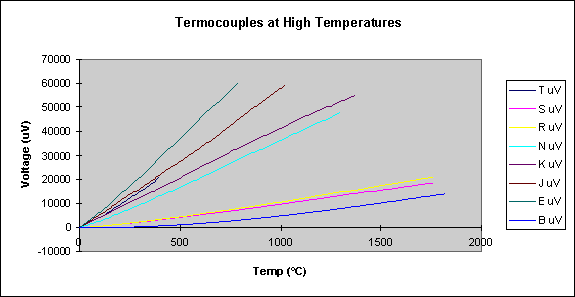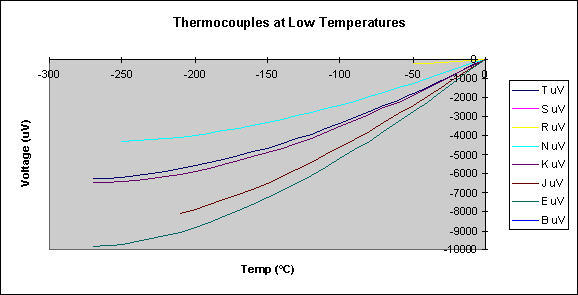Thermocouple Selection and Use
Thermocouples are the most popular temperature sensors. They are cheap, interchangeable, have standard connectors and can measure a wide range of temperatures. The main limitation is accuracy, system errors of less than 1°C can be difficult to achieve.
How they work
|
In 1822, an Estonian physicist named Thomas Seebeck discovered that the junction between two metals generates a voltage that is a function of temperature. Thermocouples rely on this Seebeck effect. Although almost any two types of metal can be used to make a thermocouple, a number of standard types are used because they possess predictable output voltages and large temperature gradients. The diagram shows a K type thermocouple, which is the most popular.
|
 |
Cold junction compensation
Standard tables show the voltage produced by thermocouples at any given temperature, so for example in the above diagram, the K type thermocouple at 300°C will produce 12.2mV. Unfortunately it is not possible to simply connect up a voltmeter to the thermocouple to measure this voltage, because the connection of the voltmeter leads will make a second, undesired thermocouple junction. To make accurate measurements, this must be compensated for by using a technique known as cold junction compensation (CJC). In case you are wondering why connecting a voltmeter to a thermocouple does not make several additional thermocouple junctions (leads connecting to the thermocouple, leads to the meter, inside the meter etc), the law of intermediate metals states that a third metal, inserted between the two dissimilar metals of a thermocouple junction will have no effect provided that the two junctions are at the same temperature. This law is also important in the construction of thermocouple junctions. It is acceptable to make a thermocouple junction by soldering the two metals together as the solder will not affect the reading. In practice, however, thermocouples junctions are made by welding the two metals together (usually by capacitive discharge) as this ensures that the performance is not limited by the melting point of solder.
All standard thermocouple tables allow for this second thermocouple junction by assuming that it is kept at exactly zero degrees centigrade. Traditionally this was done with a carefully constructed ice bath (hence the term 'cold' junction compensation). Maintaining a ice bath is not practical for most measurement applications, so instead the actual temperature at the point of connection of the thermocouple wires to the measuring instrument is recorded.
Typically cold junction temperature is sensed by a precision Thermistor in good thermal contact with the input connectors of the measuring instrument. This second temperature reading, along with the reading from the thermocouple itself is used by the measuring instrument to calculate the true temperature at the thermocouple tip. For less critical applications, the CJC is performed by a semiconductor temperature sensor. By combining the signal from this semiconductor with the signal from the thermocouple, the correct reading can be obtained without the need or expense to record two temperatures. Understanding of cold junction compensation is important; any error in the measurement of cold junction temperature will lead to the same error in the measured temperature from the thermocouple tip.
Linearisation
As well as dealing with CJC, the measuring instrument must also allow for the fact that the thermocouple output is non linear. The relationship between temperature and output voltage is a complex polynomial equation (5th to 9th order depending on thermocouple type). Analogue methods of linearization are used in low cost thermocouple meters. High accuracy instruments such as the Pico TC-08 store thermocouple tables in computer memory to eliminate this source of error.
Thermocouple types
Thermocouples are available either as bare wire 'bead' thermocouples which offer low cost and fast response times, or built into probes. A wide variety of probes are available, suitable for different measuring applications (industrial, scientific, food temperature, medical research etc). One word of warning: when selecting probes take care to ensure they have the correct type of connector. The two common types of connector are 'standard' with round pins and 'miniature' with flat pins, this causes some confusion as 'miniature' connectors are more popular than 'standard' types.
When choosing a thermocouple consideration should be given to both the thermocouple type, insulation and probe construction. All of these will have an effect on the measurable temperature range, accuracy and reliability of the readings. Listed below is our (somewhat subjective) guide to thermocouple types.
Type K (Chromel / Alumel)
Type K is the 'general purpose' thermocouple. It is low cost and, owing to its popularity, it is available in a wide variety of probes. Thermocouples are available in the -200°C to 1200°C range. Sensitivity is approx 41uV/°C. Use type K unless you have a good reason not to.
Type E (Chromel / Constantan)
Type E has a high output (68uV/°C) which makes it well suited to low temperature (cryogenic) use. Another property is that it is non-magnetic.
Type J (Iron / Constantan)
Limited range (-40 to 750°C) makes type J less popular than type K. The main application is with old equipment that can not accept 'modern' thermocouples. J types should not be used above 760°C as an abrupt magnetic transformation will cause permanent decalibration.
Type N (Nicrosil / Nisil)
High stability and resistance to high temperature oxidation makes type N suitable for high temperature measurements without the cost of platinum (B,R,S) types. Designed to be an 'improved' type K, it is becoming more popular.
Thermocouple types B, R and S are all 'noble' metal thermocouples and exhibit similar characteristics. They are the most stable of all thermocouples, but due to their low sensitivity (approx 10uV/0C) they are usually only used for high temperature measurement (>300°C).
Type B (Platinum / Rhodium)
Suited for high temperature measurements up to 1800°C. Unusually type B thermocouples (due to the shape of their temperature / voltage curve) give the same output at 0°C and 42°C. This makes them useless below 50°C.
Type R (Platinum / Rhodium)
Suited for high temperature measurements up to 1600°C. Low sensitivity (10uV/°C) and high cost makes them unsuitable for general purpose use.
Type S (Platinum / Rhodium)
Suited for high temperature measurements up to 1600°C. Low sensitivity (10uV/vC) and high cost makes them unsuitable for general purpose use. Due to its high stability type S is used as the standard of calibration for the melting point of gold (1064.43°C).
When selecting thermocouple types, ensure that your measuring equipment does not limit the range of temperatures that can be measured. Listed below is the range of temperatures that the 8 channel Pico TC-08 can measure. Note that thermocouples with low sensitivity (B, R and S) have a correspondingly lower resolution.
Range and sensitivity
When selecting thermocouple types, ensure that your measuring equipment does not limit the range of temperatures that can be measured. Listed below is the range of temperatures that the 8-channel Pico TC-08 Thermocouple Data Logger can measure. Note that thermocouples with low sensitivity (B, R and S) have a correspondingly lower resolution.
| Thermocouple type |
Overall
Range (°C)
|
0.1°C
Resolution
|
0.025°C
Resolution
|
| B |
100..1800 |
1030..1800 |
- |
| E |
-270..790 |
-240..790 |
-140..790 |
| J |
-210..1050 |
-210..1050 |
-120..1050 |
| K |
-270..1370 |
-220..1370 |
-20..1150 |
| N |
-260..1300 |
-210..1300 |
340..1260 |
| R |
-50..1760 |
330..1760 |
- |
| S |
-50..1760 |
250..1760 |
- |
| T |
-270..400 |
-230..400 |
-20..400 |
The graphs below show the voltage output from thermocouples at different temperatures. Note the platinum based thermocouples have a very low output which explains why there use is limited to the measurement of high temperatures.
Precautions and considerations for using thermocouples
Most measurement problems and errors with thermocouples are due to a lack of understanding of how thermocouples work. Listed below are some of the more common problems and pitfalls to be aware of.
Connection problems
Many measurement errors are caused by unintentional thermocouple junctions. Remember that any junction of two different metals will cause a junction. If you need to increase the length of the leads from your thermocouple, you must use the correct type of thermocouple extension wire (eg type K for type K thermocouples). Using any other type of wire will introduce a thermocouple junction. Any connectors used must be made of the correct thermocouple material and correct polarity must be observed.
Lead Resistance
To minimize thermal shunting and improve response times, thermocouples are made of thin wire (in the case of platinum types cost is also a consideration). This can cause the thermocouple to have a high resistance which can make it sensitive to noise and can also cause errors due to the input impedance of the measuring instrument. A typical exposed junction thermocouple with 32AWG wire (0.25mm diameter) will have a resistance of about 15 ohms / meter. The Pico TC-08 has an input impedance of 2MW so will have an error of less than 0.01% for 12 meters of such cable. If thermocouples with thin leads or long cables are needed, it is worth keeping the thermocouple leads short and then using thermocouple extension wire (which is much thicker, so has a lower resistance) to run between the thermocouple and measuring instrument. It is always a good precaution to measure the resistance of your thermocouple before use.
Decalibration
This is the process of unintentionally altering the makeup of thermocouple wire. The usual cause is the diffusion of atmospheric particles into the metal at the extremes of operating temperature. Another cause is impurities and chemicals from the insulation diffusing into the thermocouple wire. If operating at high temperatures, check the specifications of the probe insulation.
Noise
The output from a thermocouple is a small signal, so it is prone to electrical noise pick up. Most measuring instruments (such as the TC-08) reject any common mode noise (signals that are the same on both wires) so noise can be minimized by twisting the cable together to help ensure both wires pick up the same noise signal. Additionally, the TC-08 uses an integrating analog to digital converter which helps average out any remaining noise. If operating in an extremely noisy environment, (such as near a large motor) it is worthwhile considering using a screened extension cable. If noise pickup is suspected first switch off all suspect equipment and see if the reading changes.
Common Mode Voltage.
Although thermocouple signal are very small, much larger voltages often exist at the input to the measuring instrument. These voltages can be caused either by inductive pick up (a problem when testing the temperature of motor windings and transformers) or by 'earthed' junctions. A typical example of an 'earthed' junction would be measuring the temperature of a hot water pipe with a non insulated thermocouple. If there are any poor earth connections a few volts may exist between the pipe and the earth of the measuring instrument. These signals are again common mode (the same in both thermocouple wires) so will not cause a problem with most instruments provided they are not too large. For example, the TC-08 has a common mode input range of -4V to 4V. If the common mode voltage is greater than this then measurement errors will result. Common mode voltages can be minimized using the same cabling precautions outlined for noise, and also by using insulated thermocouples.
Thermal Shunting.
All thermocouples have some mass. Heating this mass takes energy so will affect the temperature you are trying to measure. Consider for example measuring the temperature of liquid in a test tube: there are two potential problems. The first is that heat energy will travel up the thermocouple wire and dissipate to the atmosphere so reducing the temperature of the liquid around the wires. A similar problem can occur if the thermocouple is not sufficiently immersed in the liquid, due to the cooler ambient air temperature on the wires, thermal conduction may cause the thermocouple junction to be a different temperature to the liquid itself. In the above example a thermocouple with thinner wires may help, as it will cause a steeper gradient of temperature along the thermocouple wire at the junction between the liquid and ambient air. If thermocouples with thin wires are used, consideration must be paid to lead resistance. The use of a thermocouple with thin wires connected to much thicker thermocouple extension wire often offers the best compromise.
Pico Products for measuring Thermocouples
Pico has two products designed to allow temperature to be measured and recorded using thermocouples. The TC-08 thermocouple data logger interfaces up to 8 thermocouples of any type to a PC.
|
 |
|














